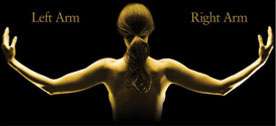Pronator Syndrome
What is pronator syndrome?
The median nerve courses with the brachial artery across the anterior aspect of the elbow and dives between the two heads of the pronator teres muscle giving muscle function to this muscle. It then goes beneath the origin of the flexor digitorum sublimis (FDS) muscle giving rise to the anterior interosseous nerve (AIN). The AIN gives muscle function to the FPL (thumb flexor), the FDP to index and middle (flexes last joint), and the pronator quadratus. The median nerve supplies the FCR, Palmaris Longus, FDS in the forearm then goes to the hand giving sensation to the T, I, M, and 1/2 R and gives muscle function to the thenar muscles and the lumbrical muscles to the I and M. There are two major points of compression. The first is between the two heads of the Pronator Teres (Pronator Syndrome) where the median nerve is involved, and the second is at the area beneath the origin of the FDS with involvement of the AIN (Anterior Interosseous Nerve Compression Syndrome).
What are causes of pronator syndrome?
Fascial bands, anomalous muscles, and trauma are the most common causes of these syndromes. Repetitive use of the hand, wrist and elbow can lead to swelling in these areas causing nerve compression.
What are the symptoms of pronator syndrome?
Pronator Syndrome (P.S.):
Slow onset of aching pain at proximal forearm or elbow at volar surface; may have a precipitating event; nocturnal pain uncommon; increased with activity particularly pronation (rotation of forearm with palm in a downward direction); numbness and tingling of T, I, M, and 1/2 of R; weakness with dexterity such as buttoning clothes or picking up of small objects
Anterior Interosseous Nerve Compression Syndrome (AINCS):
Sudden onset of pain at proximal volar forearm followed by motor weakness or paralysis (absent thumb, index, and middle distal joint flexion); may have pain at volar wrist area
How to diagnose pronator syndrome:
In addition to symptoms as listed above, the examination will reveal:
- Swelling at proximal, volar forearm
- Tenderness at point of compression
- Pressure applied at point of compression reproduces symptoms
- Tinels’ sign (thumping tissue over area causes shocks or tingling (paresthesias) within the hand (P.S.)
- Sensation diminished to the T, I, M, 1/2 R (P.S.)
- Muscle weakness: FPL, FDP (I, M), Pronator Quadratus only if AINCS; may involve all muscles supplied by median nerve (including AIN muscles) if P.S.
Additonal tests are helpful:
- X-rays of elbow and forearm: To rule out underlying joint or bone abnormality
- Electrodiagnostic tests (NCV/EMG): Can be helpful particularly to pick up loss of muscle function in certain muscles in severe cases; slowing of NCV at the elbow can help diagnose P.S.
What is the non-surgical treatment of pronator syndrome?
Pronator Syndrome:
Conservative initially if no weakness of muscles with limiting repetitive movement, NSAID (i.e. Advil) by or steroids, and therapy.
Anterior Interosseous Nerve Compression Syndrome:
If this is secondary to trauma (i.e. elbow dislocation) then observation for 6-8 weeks may allow return of function without surgery.
What is the surgical treatment of pronator syndrome?
Pronator Syndrome:
If conservative treatment fails or if weakness or paralysis is present, then decompression is necessary to minimize irreversible muscle weakness.
Anterior Interosseous Nerve Compression Syndrome:
If no trauma, then aggressive treatment with surgical decompression is recommended, as the risks of surgery are much less than the chance of irreversible motor weakness if left untreated for several months.
Surgical recovery:
Patients return 8-10 days after surgery for suture removal; their long arm splint is changed at that time; 2 weeks later the splint is removed and they are sent to therapy for a removeable splint that is worn for 2 weeks at night and when not exercising; therapy is started and lasts ~ 6-8 weeks depending on the severity.
How can Dr. Knight help your pronator syndrome?
Dr. Knight knows that pronator syndrome can be difficult to diagnose. With his years of experience in the treatment of peripheral nerve problems, he will take a careful history and perform a detailed examination to confirm the diagnosis. He will then begin conservative treatment. If necessary through minimally invasive techniques, he may need to relieve pressure on the nerve. No matter what the treatment needed Dr. Knight will return you to your active pain free lifestyle as quickly as possible.
Disclaimer
HandAndWristInstitute.com does not offer medical advice. The information presented here is offered for informational purposes only. Read Disclaimer

